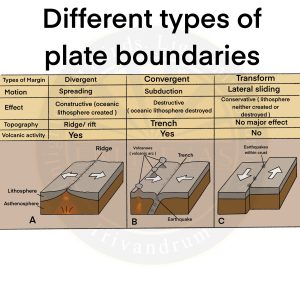Definition
- A plate is a broad segment of the lithosphere that floats on the underlying asthenosphere and moves independently of the other plates.
Major and Minor Lithospheric Plates
- Major Lithospheric Plates
- Antarctica and the surrounding oceanic plate
- North American plate
- South American plate
- Pacific plate
- India-Australia-New Zealand plate
- Africa with the eastern Atlantic floor plate
- Eurasia and the adjacent oceanic plate
- Minor Lithospheric Plates
- Cocos plate: Between Central America and Pacific plate
- Nazca plate: Between South America and Pacific plate
- Arabian plate: Mostly the Saudi Arabian landmass
- Philippine plate: Between the Asiatic and Pacific plate
- Caroline plate: Between the Philippine and Indian plate (North of New Guinea)
- Fuji plate: North-east of Australia
- Turkish plate
- Aegean plate (Mediterranean region)
- Caribbean plate
- Juan de Fuca plate (between Pacific and North American plates)
- Iranian plate.
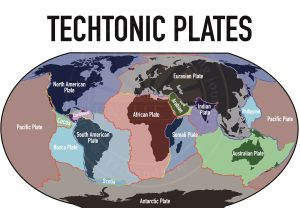
Type of Plate Boundaries
- Divergent Boundaries
- A divergent boundary occurs when two tectonic plates move away from each other.
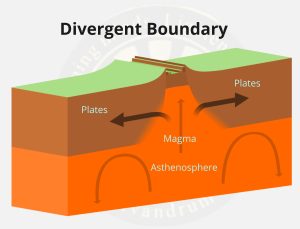
-
- Associated Features
- Earthquake: Divergence of plates causes isostatic imbalance triggering earthquake waves.
- Volcanism: Gaps created due to divergence of plates led to emergence of molten magma from the mantle to the surface. For example – Mount Gahinga volcanoes in the East African Rift between the African and Arabian plates.
- Creation of Rift Valleys: Divergent boundaries can also develop within a continent resulting in a continental rift valley such as The East African Rift, and the Baikal Rift Valley.
- Associated Features
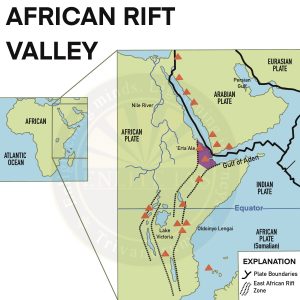
- Convergent Boundaries
- When two plates come together, it is known as a convergent boundary.
- Common outcomes of convergence are volcanism, earthquakes, formation of trenches, fold mountains etc.
- Three types of convergent boundaries are
- Oceanic–continental Convergence
- Oceanic crust may collide with a continent. The oceanic plate is denser, so it undergoes subduction.
- This means that the oceanic plate sinks beneath the continent and melts in the hot asthenosphere leading to the emergence of volcanic islands.
- It also leads to the formation of fold mountains .
- For example – Pacific Ring of Fire, and Andes mountains.
- Oceanic–continental Convergence
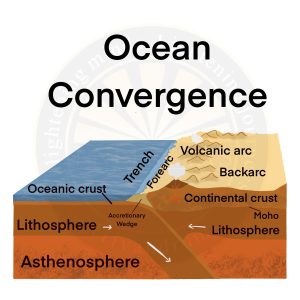
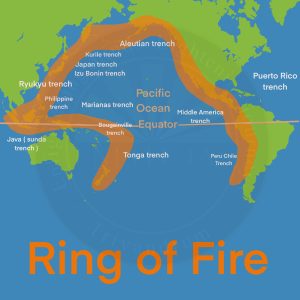
-
-
- Ocean–Ocean Convergence
- In collisions between two oceanic plates, the cooler, denser oceanic lithosphere sinks beneath the warmer, less dense oceanic lithosphere.
- As the slab sinks deeper into the mantle, it releases water from dehydration of hydrous minerals in the oceanic crust.
- Leads to the formation of oceanic trenches, shallow and deep-focus earthquakes and volcanic activity.
- For example – Aleutian Islands and the Mariana Islands.
- Continent-Continent Convergence
- Continent-Continent (C-C) convergence is formed between two continental plates.
- When the plates converge, oceanic sediments are squeezed and upthrust between the plates and these squeezed sediments appear as fold mountains along the plate margins.
- For example – Himalayan mountains
- Ocean–Ocean Convergence
-
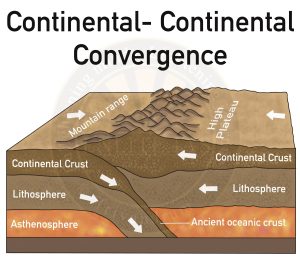
- Transform Boundaries
- A transform boundary is formed as tectonic plates slide horizontally past each other but parts of these plates get stuck at the places where they touch.
- These boundaries are conservative because plate interaction occurs without creating or destroying crust.
- For example – San Andreas Fault in California
